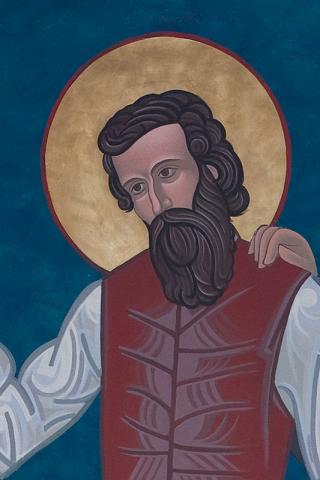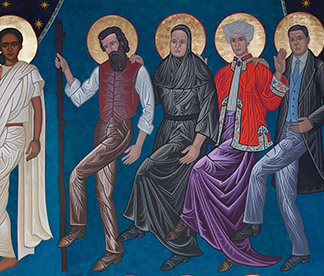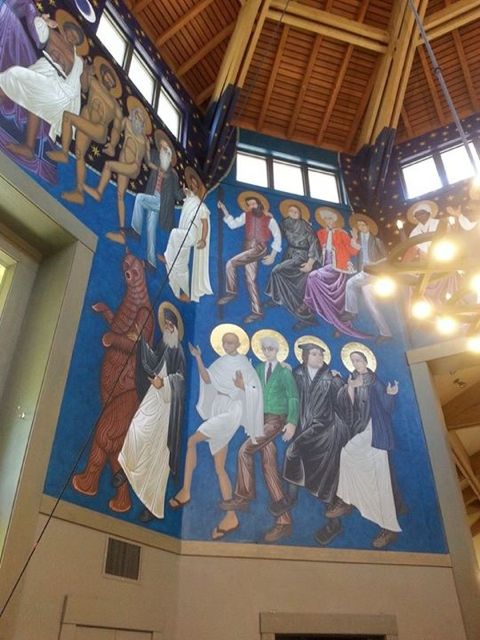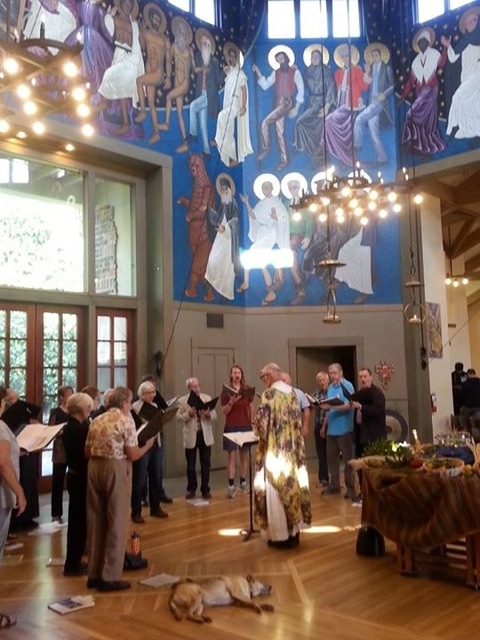the john muir exhibit - life - saint john muir
Saint John Muir
by Harold Wood
 John Muir is often called a "wilderness prophet" and "the "patron saint of the American wilderness," but the use of such terms are typically metaphorical, not religious.
John Muir is often called a "wilderness prophet" and "the "patron saint of the American wilderness," but the use of such terms are typically metaphorical, not religious.
However, it appears that now at least one major religious denomination has actually posited a form of "sainthood" on John Muir.
John Muir has been added to the list of "Holy Women, Holy Men: Celebrating the Saints" by the Episcopal Church of America.[1]
The book describes a kind of minor annual "Feast Day" ceremony on April 22 for Muir, along with a contemporary of his, an Episcopalian priest-explorer. This guide book to 'Holy Women, Holy Men" includes a brief biography of Muir, followed by two readings, called "Collects," which offer thanks to the "Creator of the earth and all that inhabits it" for "thy prophets John Muir and Hudson Stuck, who rejoiced in your beauty made known in the natural world..." The reading calls upon parishioners to be "inspired by their love of thy creation," so that "we may be wise and faithful stewards of the world thou has created, that generations to come may also lie down to rest among the pines and rise refreshed for their work......"
John Muir is listed in Holy Women, Holy Men, along with Hudson Stuck (1863-1920), who was a an Episcopal priest, mountain-climber, and explorer. In 1905, Stuck moved to Fort Yukon, Alaska, where he spent the rest of his life, serving as archdeacon of the Diocese of Alaska.
Organizing and leading a group of fellow explorers, Stuck was the first to completely ascend Denali (Mt. McKinley) in 1913. He later wrote of the experience as a "privileged communion" to be received in awe and wonder. Upon reaching the pinnacle of Denali, Stuck led the climbers in prayer and thanksgiving.
Although they were roughly contemporaries, there is no evidence that Muir ever met Hudson Stuck, although both men were aware of each other. Rev. Stuck wrote a letter to to John Muir, dated June 17, 1914, along with a copy of his two Alaskan wilderness adventure books, praising Muir's writings as "one of the dearest, sweetest influences of the literature of today," and predicting that they would "become classics with those who love the face of Nature." Thus, Muir's personal library included a copy of Hudson Stuck's The Ascent of Denali, along with Stuck's 1914 book Ten Thousand Miles With a Dog Sled, in which he praised John Muir's book The Mountains of California as "surely the finest mountain book ever written."
An excerpt from the portion of "Holy Women, Holy Men" focused on John Muir and Hudson Stuck is offered on the Holy Women, Holy Men blog of the Standing Commission on Liturgy and Music of the Episcopal Church.
John Muir in the Dancing Saints
 John Muir as an Episcopal "saint" is further celebrated in "The Dancing Saints Icons" project at Saint Gregory of Nyssa Episcopal Church in San Francisco. This is an artwork by iconographer Mark Dukes and the All Saints Company. Muir is represented among some 100 others in a spectacular 2,300-square-foot iconographic mural that encircles the rotunda walls of the church. According to the church brochure. "The Dancing Saints Icon depicts 100 saints chosen by the congregation, larger than life and in dancing poses that model a distinctive feature of our worship." This church incorporates dancing as a major part of its liturgy in its worship services. As author Brian D. McLaren describes it, by portraying the saints dancing together, rather than sitting on thrones of authority as they do in much ancient iconography, the mural suggests that they are inviting us to today to join them in the dance of justice, joy, and peace..." One parishioner states, "I experience a wonderful thing at St. Gregory's when we dance in a circle. We
have our hand on the shoulder of the person in front of us and we are doing a simple
Greek step together, going around in a circle."
John Muir as an Episcopal "saint" is further celebrated in "The Dancing Saints Icons" project at Saint Gregory of Nyssa Episcopal Church in San Francisco. This is an artwork by iconographer Mark Dukes and the All Saints Company. Muir is represented among some 100 others in a spectacular 2,300-square-foot iconographic mural that encircles the rotunda walls of the church. According to the church brochure. "The Dancing Saints Icon depicts 100 saints chosen by the congregation, larger than life and in dancing poses that model a distinctive feature of our worship." This church incorporates dancing as a major part of its liturgy in its worship services. As author Brian D. McLaren describes it, by portraying the saints dancing together, rather than sitting on thrones of authority as they do in much ancient iconography, the mural suggests that they are inviting us to today to join them in the dance of justice, joy, and peace..." One parishioner states, "I experience a wonderful thing at St. Gregory's when we dance in a circle. We
have our hand on the shoulder of the person in front of us and we are doing a simple
Greek step together, going around in a circle."
Accordingly, the Dancing Saints Icons represented on the rotunda depict the 100 saints in the same pose. Some of the saints represented are Lady Godiva with her horse, Sadi with tiger, John Coltrane, Francis of Assisi with wolf, John Muir, Charles Darwin, Teresa of Avila, Sojourner Truth, Mahatma Gandhi, and many others.
They, and the church's parishioners, are said to share John Muir's faith that "No portion of the world is so barren as not to yield a rich and precious harvest of divine truth."
John Muir himself is depicted holding a walking stick, wearing a laced shirt, and like the rest of the "dancing saints" with a golden halo.
In the line behind Muir on the Northwest Panel of the rotunda is Maria Skobtsova, Donaldina Cameron,
and Chiune Sugihara.

St. Gregory of Nyssa Episcopal Church also hosts special events honoring John Muir. All during September 2014, they celebrated John Muir as a "prophet, naturalist, environmental activist, writer, mountain man, California fruit farmer, Valencia Street apartment dweller and preacher of the glory of all creation" — commemorating the hundredth anniversary of his death. Starting with a church camping trip, the church celebrated a "Wild Glory Mass" on September 7 at St. Gregory's. 
The "Wild Glory Mass" included a "Hymn to John Muir" composed by one of the parishioners, Scott King, performed by the church choir.
Another choral piece celebrating John Muir at the congregation has been composed by parisioner Libby McQuiston, "Nature's Repose" that includes both a biography and lyrics based on John Muir's writings.
The church observed, "We remember that God's word is revealed by John Muir's own habits of attention, surrender and praise, and invite everyone to practice noticing wild glory in every place, every day."
The church encourages members to walk to these special events, recognizing that "John Muir walked from Indiana to Florida, from Martinez to the Sierras, up and down the valleys of Yosemite, along Valencia Street in the Missio ... and with every step he saw something new." The church encourages folks to emulate the spirit of John Muir with journal entries, photos, sketches and observations: "Walk, notice, keep a journal with your observations!"
A "prayer card" posting at the church on September 7 even stated, "Pray for John Muir and the Sierra Club."
Conclusion
It is not surprising that Muir is considered an inspirational religious figure. After reviewing one of his manuscripts, an editor of The Atlantic Monthly said, 'I felt almost as if I had found religion! [2] Of course, John Muir never expressed his religious views in theological analysis,
but rather in experiential hosannas. He simply saw Beauty and God as identities: "No synonym for God is so perfect as Beauty. Whether as seen
carving the lines of the mountains with glaciers, or gathering matter into stars, or planning the movements of water, or gardening - still all is
Beauty!"[3]
And so it is not only the Episcopalians who embrace John Muir as one of their own spiritual inspirations. As one Muir scholar put it, "The broader religious dimension of Muir's relationship with nature has been a favorite subject of speculative analysis, with a startling - even baffling - array of results." [4] One school of thought asserts that Muir made a permanent break from Christianity during his thousand mile walk to the Gulf .[5]
Some claim and celebrate John Muir's views as closer to Zen Buddhism, or at least embrace him as a Buddhist-compatible "Teacher," [6]. In the 1980's, Deep Ecologist philosopher George Sessions labeled John Muir "the Taoist of the West." [7] In 2016, biologist and Taoist practitioner Raymond Barnett asserts that John Muir was an "accidental Taoist." [8] Others assert that John Muir was plainly a pagan [9] or a Neo-Pagan.[10]. Modern Pantheists celebrate John Muir today, calling him a "Pantheist Prophet," and celebrate his birth date each April 21st..
[11]
But another school of thought claims that Muir only rejected religious sectarianism, not
Christianity per se. [12] Modern Presbyterian minister Richard Cartwright Austin asserts: "I hear John Muir speaking as... a prophet, telling us that God wants humans to care for nature and not destroy the systems of life."[13] Author Lowell Young argues that "Perhaps it is also not a reach to deduce that if Muir had been a member of the Roman Catholic Church, he would have been canonized long ago." He points out that ""One of the prerequisites of achieving sainthood is an act of performing a miracle. Because Muir was such a spiritual giant, few would argue that his life, works and legacy have [not] provided inspiration, comfort, even healing for countless millions of people, many of who have experienced Nature-induced "born-again experiences."[14]
The key point missing in all these academic debates is the failure to recognize that religious views of anyone are rarely walled off into separate silos. In our modern world of diversity, we would do well to appreciate the inter-blendings of various religious overlapping ideas, which John Muir himself recognized when he said, "God does not appear, and flow out, only from narrow chinks and round bored wells here and there in favored races and places, but He flows in grand undivided currents, shoreless and boundless over creeds and forms and all kinds of civilizations and peoples and beasts, saturating all and fountainizing all."[15]
Perhaps, like the particular Episcopalian expression in their liturgy and as celebrated at the St. Gregory's of Nyssa Episcopalian Church, rather than scholarly debate about the nature of Muir's religion, we may find something rather more valuable in appreciating how and why John Muir is so frequently celebrated by such a wide variety of religious traditions.
Clearly, not only the Episcopalians, but many others celebrate John Muir as a spiritual messenger. The fact that Muir can be embraced by people of many different religious persuasions is only a measure of his greatness.
But who or what is a true "saint"? John Muir himself did not ascribe saintly qualities to any person, but rather to Nature itself: "The sun is a saint, so is the snow and the glaciers and every virgin river." [16] Muir can be embraced by many traditional religious persuasions, but his was "the pure religion of sunshine and snow." [17]
Endnotes
[1] Holy Women, Holy Men Celebrating the Saints (Conforming to General Convention 2009), New York: Church Publishing 2010). This book lists, along with over 200 others, "John Muir, Naturalist and Writer, 1914." In 2009, John Muir was added along with some 100 new names included in Holy Women, Holy Men. As a replacement for the Episcopal Church's Lesser Feasts and Fasts, the book "seeks to expand the worshipping community's awareness of the communion of saints..." Presented as a calendar of special days throughout the church year,
this publication states: "The men and women commemorated in the Calendar are not simply examples of faithfulness to inspire us: they are active in their love and prayer. They are companions in the spirit able to support and encourage us as we work to be faithful in our own day." Although John Muir's Birthday is actually April 21, the Episcopal Calendar celebrates his "Saint's Day" as April 22, along with" Hudson Stuck, Priest and Environmentalist, 1920."
The date April 21 is reserved for "Anselm, Archbishop of Canterbury, 1109."
Available as a PDF or in print format.
[2]
Wolfe, Linnie Mash Wolfe, Son of the Wilderness: The Life of John Muir, (1945), p. 328.
[3] Wolfe, Linnie Marsh, John of the Mountains: The Unpublished Journals of John Muir, (1938), pg 208.
[4] Holmes, Stephen J., The Young John Muir: An Environmental Biography (University of Wisconsin Press, 1999).
[5] This view is represented by Stephen Fox, John Muir and His Legacy: The American Conservation
Movement (Boston: Little, Brown & Co. 1981); Michael Cohen [Michael P. Cohen, The Pathless Way: John Muir and the American
Wilderness (Madison: University of Wisconsin Press, 1984); and Max Oelschlager [Max Oelschlager, The Idea of Wilderness (New Haven: Yale University Press, 1991).]
[6] "
Zen Buddhism in John Muir"
by Michelle L. Dwyer (Reprinted from the John Muir Newsletter Vol. 5, no. 2, Spring, 1995). See also: "Our Teachers: John Muir" The Chenrezig Project: Infusing Western Life with Tibetan Buddhist Compassion; Wisdom Quarterly: American Buddhist Journal: "John Muir's Plant People (devas)"
[7] Cohen, Michael, The Pathless Way: John Muir and
American Wilderness (Madison: The University of Wisconsin
Press, 1984), pg. 120.
8] See Earth Wisdom: John Muir, Accidental Taoist, Charts Humanity's Only Future on a Changing Planet by Raymond Barnett (2016). See also Book Review by Harold Wood, 2023, and the book's Introduction and Reviews on Raymond Barnett's own website.
[9] In this vein, retired Presbyterian and professed non-Christian Chris Highland asserts unequivocally that John Muir was a Pagan, because "Muir's wide-open sense of church" leads to the conclusion that "his natural spirituality grew beyond the parochial Christian God to a more Universal Creator or Creative Energy acknowledged by Wiccans, Pagans, and mystics." John Muir was a Pagan by Chris Highland (September 15. 2009).
[10]
See John Muir, Wilderness Prophet by Neo-Paganism.com
[11] See Universal Pantheist Society, Pantheist Vision: Special Issue: "John Muir: Pantheist Prophet" (1988) "Man's Place in the Universe" by John Muir; A New Commemorative Holiday: John Muir Day; Pantheist Prophets: John Muir 1838-1914. and its 2014 Pantheist Holidays (Kindle ebook).
(Kindle ebook).
[12] See Limbaugh, Ronald H., "The Nature of John Muir's Religion" in The Pacific
Historian: John Muir: Life and Legacy , Vol 29, No. 2 & 3 (Stockton:
University of the Pacific, Summer/Fall, 1985; Richard
Austin [Austin, Richard Cartwright, Baptized into Wilderness: A Christian Perspective on John Muir (Atlanta: John Knox Press, 1987]. ] , and Dennis Williams [God's Wilds: John Muir's Vision of Nature
By Dennis C. Williams
(College Station: Texas A & M University Press, 2002]) ,
[13] Austin, Richard Cartwright, Baptized into Wilderness: A Christian Perspective on John Muir (Atlanta: John Knox Press, 1987].
[14] Young, Lowell H. "St. John of the Mountains," in
Napa Valley Register, April 14, 2019.
[15] Muir, John, letter to Catharine Merrill, dated June 9th, 1872, reprinted in The Life and Letters of John Muir.
[16] Muir, John, "Travels in Utah," John Muir Papers, 25:1321, quoted in Worster, Donald, A Passion for Nature: The Life of John Muir (New York: Oxford University Press, 2009), p. 230.
[17] Muir, John, Steep Trails, Chapter 6: The City of the Saints.
Date: June 29, 2014; Updated September 14, 2014; June 10, 2018, June 30, 2018, April 17, 2019.
"Wild Glory Mass" photos courtesy of Bernie Zaleha.
Home
| Alphabetical Index
| What's New & About this Site